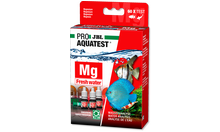Healthy aquariums with conditions close to nature
The right water values are dependent on the fish stock and the plants in the aquarium. Even if the water looks clear it can be contaminated. With bad values diseases or algae can appear in the aquarium. To maintain a healthy aquarium with conditions close to nature it is important to check and adapt the water values regularly.
For each water analysis JBL provides water tests in the form of rapid tests or colour change tests. These determine a certain value or several values in one go. With these water tests you can recognise algae problems and negative nitrate, nitrite, potassium, magnesium values etc.
Why test?
The well-being of auqarium dwellers and the healthy growth of aquatic plants depend to a large extent on the pH level being kept as constant as possible. Many substances dissolved in water are also liable to changes caused by the pH level. Fluctuations in the pH level in particular ought to be avoided.
JBL Online Laboratory
Regular monitoring for a healthy aquarium with conditions close to nature. Enter your water values into the JBL Online Laboratory and get an in-depth analysis of your values within seconds.
Recommended pH values:
Freshwater aquarium (community aquarium) 6.5-7.5;
Lake Malawi & Lake Tanganyika aquariums 7.8-9.2
Plant aquarium with few fish (aquascaping): 6.0-7.0
Marine aquariums: 7.9-8.5
Ponds: 7.5-8.5
JBL PROAQUATEST pH 6.0-7.6
Quick test to determine the pH values in the range 6.0-7.6 in freshwater aquariums
- Simple and reliable monitoring of the aquarium water values. Determines the ideal pH value in freshwater aquariums
- Laboratory comparator system to compensate the inherent water colour: fill plastic cuvette with sample water, add reagent to one cuvette, place both cuvettes in holder, read values off colour chart
- When to use: daily for one week in newly set up aquariums, afterwards weekly
- Online Laboratory: regular monitoring for a healthy aquarium with natural conditions. JBL has water tests in the form of quick tests or colour change tests for every water analysis. Testing aquarium water for healthy, clear water
- Package contents: 1 quick test, pH test 6.0-7.6 for approx. 80 measurements. Incl. reagent, 2 glass vials with screw caps, syringe, comparator block and colour scale. Reagent refill separately available






















































































